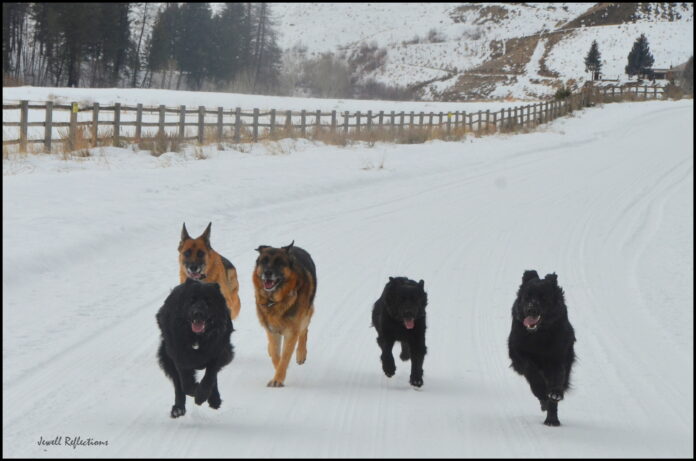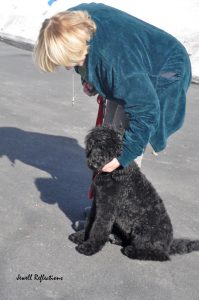
BY FRAN JEWELL

A dog jumping on people is probably one of the easiest things to stop, unless you wait too long. It is a huge problem in my book because it is dangerous—yes, dangerous! If someone has a hidden disability, such as being on blood thinners, having balance issues, or is afraid of dogs, any dog, large or small, can hurt someone badly. If your jumping dog does hurt someone, you are the responsible party. Jumping is not friendly; it is not attention seeking; it is not cute, as some might think.
Many call jumping an “attention-seeking” behavior. It is not. Dogs are literalists. In the dog world, it’s very simple—the higher you are, the higher you are in social status. Puppies, in particular, are seeking understanding about where they fit in the social structure. It is not meant as anything malicious. It is just a way for a pup to find out who he is in relationship to every person and dog he meets. When we pet our dog for jumping, we are literally saying to them that they are the same as we are in social status.
Why is that a problem? Because it reinforces lack of respect from the dog for people. In the dog world, a higher-ranking dog will correct a youngster or a dog that is disrespectful by growling, lifting a lip, standing up, or even walking away. When a dog does not respect people, it leads to nipping, biting, more jumping, pulling on the leash, separation anxiety, and even aggression.
Every species on the planet has a social structure or hierarchy. For us to truly adore our dogs, we need to teach them to respect people in a manner that they understand. This is important for them to fit into our society.
I hear over and over that people will turn their back on a jumping dog. I find this information on the Internet ineffective. Does one dog do that to another to stop it? A submissive dog may turn its back. Let’s be honest. It never stops the jumping behavior. If you look at this the way a dog does, it says to that dog that you are submitting to him. Turning your back on a dog sends him a totally inappropriate message and encourages more jumping.
The proper way to address jumping is to walk into the jumping dog until he turns his back toward you and walks away. It says to the jumper that you are reclaiming your personal space and that he should respect you. It is nonviolent, but speaks to the dog in a manner that he understands.
The second part of this is to reinforce no jumping as good behavior with petting or treats and a very proud voice.
The non-jumping dog is a joy to live with and your friends and those you meet on the trail will deeply appreciate it.
Fran Jewell is an Idaho Press Club award-winning columnist, IAABC-certified dog behavior consultant, NADOI-certified instructor #1096 and the owner of Positive Puppy Dog Training, LLC, in Sun Valley. For more information, visit positivepuppy.com or call (208) 578-1565.


